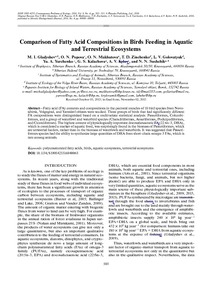Показать сокращенную информацию
Comparison of fatty acid compositions in birds feeding in aquatic and terrestrial ecosystems
| Автор | Гладышев, М. И. | |
| Автор | Попова, О. Н. | |
| Автор | Махутова, О. Н. | |
| Автор | Зинченко, Т. Д. | |
| Автор | Головатюк, Л. В. | |
| Автор | Юрченко, Ю. А. | |
| Автор | Калачёва, Г. С. | |
| Автор | Крылов, А. В. | |
| Автор | Сущик, Н. Н. | |
| Дата внесения | 2016-11-11T08:52:11Z | |
| Дата, когда ресурс стал доступен | 2016-11-11T08:52:11Z | |
| Дата публикации | 2016 | |
| Библиографическое описание | Гладышев, М. И. Comparison of fatty acid compositions in birds feeding in aquatic and terrestrial ecosystems [Текст] / М. И. Гладышев, О. Н. Попова, О. Н. Махутова, Т. Д. Зинченко, Л. В. Головатюк, Ю. А. Юрченко, Г. С. Калачёва, А. В. Крылов, Н. Н. Сущик // Contemporary Problems of Ecology. — 2016. — Т. 9 (№ 4). — С. 503-513 | |
| ISSN | 19954255 | |
| URI (для ссылок/цитирований) | https://elib.sfu-kras.ru/handle/2311/27983 | |
| Аннотация | Fatty acid (FA) contents and compositions in the pectoral muscles of 18 bird species from Novosibirsk, Volgograd, and Yaroslavl oblasts were studied. Three groups of birds that had significantly different FA compositions were distinguished based on a multivariate statistical analysis: Passeriformes, Columbiformes, and a group of waterfowl and waterbird species (Charadriiformes, Anseriformes, Podicipediformes, and Ciconiiformes). The highest content of physiologically important docosahexaenoic acid (22:6n-3, DHA), which is considered a marker of aquatic food, was surprisingly found in the biomass of Passeriformes, which are terrestrial feeders, rather than in the biomass of waterfowls and waterbirds. It was suggested that Passeriformes species had the ability to synthesize large quantities of DHA from short-chain omega-3 FAs, which is rare among animals. | |
| Ссылка на другой сайт | http://www.sibran.ru/en/journals/issue.php?ID=168310&ARTICLE_ID=168321 | |
| Тема | polyunsaturated fatty acids | |
| Тема | birds | |
| Тема | aquatic ecosystems | |
| Тема | terrestrial ecosystems | |
| Название | Comparison of fatty acid compositions in birds feeding in aquatic and terrestrial ecosystems | |
| Тип | Journal Article | |
| Тип | Journal Article Postprint | |
| Страницы | 503-513 | |
| ГРНТИ | 34.35 | |
| Дата обновления | 2016-11-11T08:52:11Z | |
| DOI | 10.1134/S1995425516040065 | |
| Институт | Институт фундаментальной биологии и биотехнологии | |
| Подразделение | Кафедра водных и наземных экосистем | |
| Журнал | Contemporary Problems of Ecology | |
| Квартиль журнала в Scopus | Q3 | |
| Квартиль журнала в Web of Science | Q4 |

